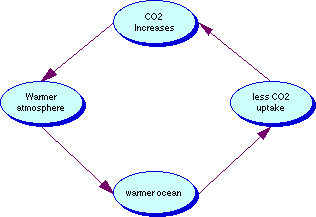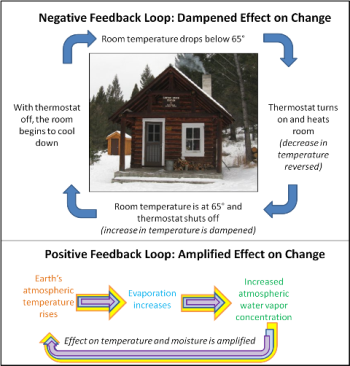 A positive feedback loop increases the effect of the change and produces instability.
A positive feedback loop increases the effect of the change and produces instability.
 Negative feedback loops operate in the same fashion, reversing the initial action that triggered the feedback loop.
Negative feedback loops operate in the same fashion, reversing the initial action that triggered the feedback loop.
Feedback Loops and Climate. In many respects, the history of Earth’s climate system can be seen as a bit of a battle between these two types of feedbacks, but in the end, the negative feedbacks win out and our climate is generally stable with a limited range of change (excepting, of course, a few extremes such as the Snowball Earth events back around 750 Myr ago). NEGATIVE FEEDBACK LOOP: Whereas negative feedback loops reduce the effects of climate change. It occurs in response to some kind of stimulus. This may either dampen down the initial change process (negative feedback loop) or amplify and intensify it (positive feedback loop). The sweat reduces body temperature and will continue until you are back to acceptable body temperature. The melting of Arctic sea ice is an example of a positive feedback loop. So a feedback is essentially a loop of cause and effect. Some climate processes work the same way, a negative climate feedback decreases some initial change in the climate and push the climate back to its original state. A positive feedback accelerates a temperature rise, whereas a negative feedback decelerates it. Positive feedbacks are amplifiers and negative feedbacks are stabilizers. Two clear, powerful examples of a positive climate feedback loops are happening now in the Arctic. Start studying negative feedback loop. Comments from expert scientist; The applets are easy to follow and the graphics are well done. Figure 9: Climate Feedback Loops ... while negative (damping) feedbacks offset some of the temperature change associated with a climate forcing. Just a quick explanation of what a positive and a negative feedback loop is in relation to climate change, as well as a simple example of each would be greatly appreciated! And there's two basic types of feedbacks. The nineteen I currently know about are described below. This essay updates my earlier effort to tally and describe self-reinforcing feedback loops with respect to climate change.At that time, seven months ago, we had strong evidence of nine such catastrophic phenomena. Often it causes the output of a system to be lessened; so, the feedback tends to stabilize the system. Clouds have made fools of climate modelers. Vital Signs of the Planet: Global Climate Change and Global Warming. For further explanation on what a negative feedback is in general, click here. Negative Feedback. POSITIVE FEEDBACK LOOP: In a positive feedback loop, an initial warming triggers a feedback to amplify the effects warming. Here is an example of a negative feedback mechanism--> In reality, there are a large number of feedback mechanisms that … This lesson does an effective job of presenting positive and negative feedback loops and how negative feedback loops create a relatively stable climate system. Climate Feedback. Climate Feedback. The thing about climate change is, the worse it gets – the worse it gets. Clouds provide negative feedback "Climate models used by the International Panel on Climate Change (IPCC) assume that clouds provide a large positive feedback, greatly amplifying the small warming effect of increasing CO2 content in air.
 A positive feedback loop increases the effect of the change and produces instability.
A positive feedback loop increases the effect of the change and produces instability. Negative feedback loops operate in the same fashion, reversing the initial action that triggered the feedback loop.
Negative feedback loops operate in the same fashion, reversing the initial action that triggered the feedback loop. A positive feedback loop increases the effect of the change and produces instability.
A positive feedback loop increases the effect of the change and produces instability. Negative feedback loops operate in the same fashion, reversing the initial action that triggered the feedback loop.
Negative feedback loops operate in the same fashion, reversing the initial action that triggered the feedback loop.